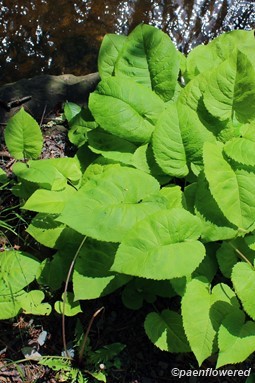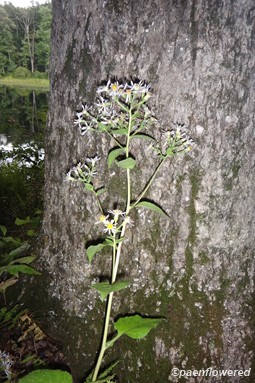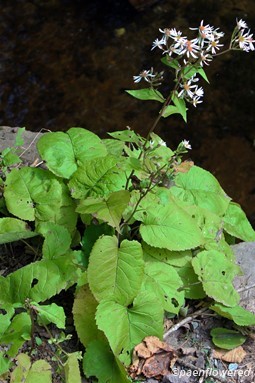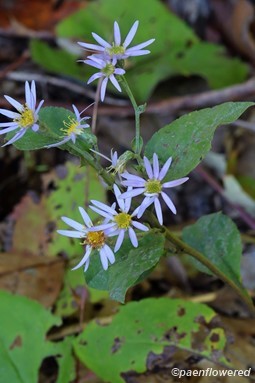Eurybia macrophylla
A native aster with large, heart-shaped leaves
Eurybia macrophylla large-leaved aster
Add to MyPlants View Locations
The large, rough, heart-shaped basal leaves make this native perennial aster easy to recognize. These leaves are up to 8 inches long, 6 inches wide, and sharply toothed. During the summer these may form a "carpet" on the forest floor. The largest basal leaves wither away leaving only the stem leaves at the time of flowering. These are about 3 inches wide and 4 inches long. The uppermost stem leaves are small, ovate, and sessile.
The composite flower heads consist of 8-16 light violet or lavender ray flowers surrounding 20-40 yellow disk flowers that turn red with age. These flower heads are 1/2 to 1-1/4 inch in diameter and have no scent. The floral bracts usually have blunt, broad tips and the flowering branches are hairy and sticky with tiny glands. These glands may require a hand lens to see. The flower cluster tends to be flat. The nectar does attract a wide variety of insects.
The large-leaved aster grows to a height of 1-5 feet. It can be found in eastern Canada and the northeastern United States. In the mountains, it can be found as far south as the Carolinas or Georgia. The young leaves can be cooked and eaten and do serve as food for a variety of caterpillars, birds, and mammals. Grouse and turkey eat the seeds. Native Americans made tea from the root and used it to relieve headaches. They also used the plant as a hunting charm. It tends to grow in clearings, especially in beech, maple, and hemlock forests.
After the basal leaves are gone, this species may be mistaken for the heart-leaved aster or white wood aster, but the shape of the flower cluster, the size of the larger stem leaves, the form of the bract and the upper stem glands are distinctive.
Habitat & Range
Frequent in moist, often rocky woods.
Present throughout the state.
| EMP: | UPL |
|---|---|
| NCNE: | UPL |
Phenology
Flowers September through mid October.
Plant Codes
S-rank: No rank
G-rank: G5 (Secure)
Eurybia macrophylla large-leaved aster
Synonyms: Aster macrophyllusAdd to MyPlants View Locations







Comments
Have you spotted this plant in your area? We'd love to hear about your experience! Share your comments or questions about the plant below. Comments are moderated before posting.